Even though the marble queen isn’t the most popular pothos variety, it’s one of our personal favorites! Like all pothos plants, they’re a perfect starter houseplant because they’re resilient, low-maintenance, and fast-growing. Plus, we think it has some of prettiest leaves of all.
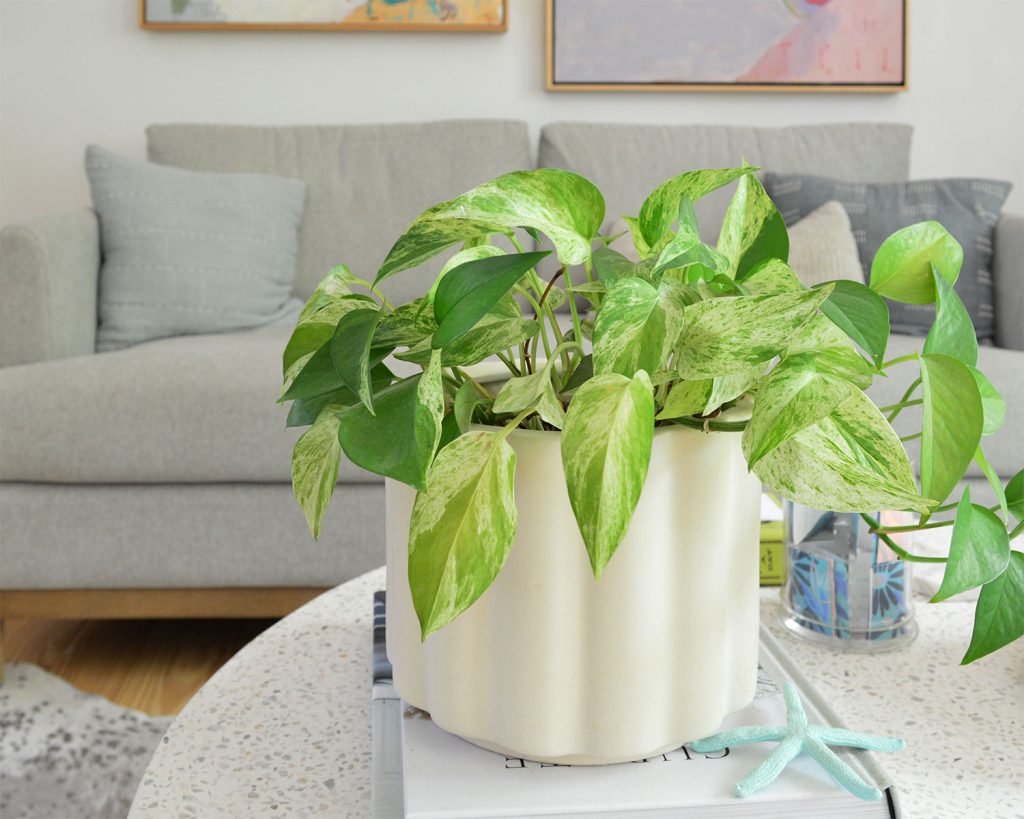
There are over a dozen kinds of pothos, most of which share similar characteristics and care instructions as the marble queen. You can read more about other pothos we love, like the golden pothos and neon pothos. These beauties are so hard to kill, they’ve even earned the nickname “Devil’s Ivy!
Marble Queen Quick Facts
Here’s what you need to know about your marble queen pothos at a glance:
- Latin name: Epipremnum aureum ‘Marble Queen’
- Common names: Marble queen pothos, marble pothos, pothos marble
- Mistaken for: Golden pothos, snow queen pothos
- Light: Prefers medium, indirect sunlight but is low-light tolerant
- Watering: Every 7-10 days during its growing season, or if the soil is dry & leaves are drooping
- Soil: Standard potting mix as long as it drains well
- Ideal Humidity: Average household humidity, ideally 50-70%
- Ideal Temperature: 60ºF to 85ºF
- Cold Hardiness: USDA Zones 10-12
What Is A Marble Queen Pothos?
Marble queen pothos (Epipremnum aureum ‘Marble Queen’) is a variety of evergreen vine sometimes called marble pothos or pothos marble. This name refers to the distinct white “marbling” on its deep green leaves. It is sometimes mistakenly sold as a golden pothos, but you can identify a marble queen by the heavy white speckles, spots, or stripes on its leaves.
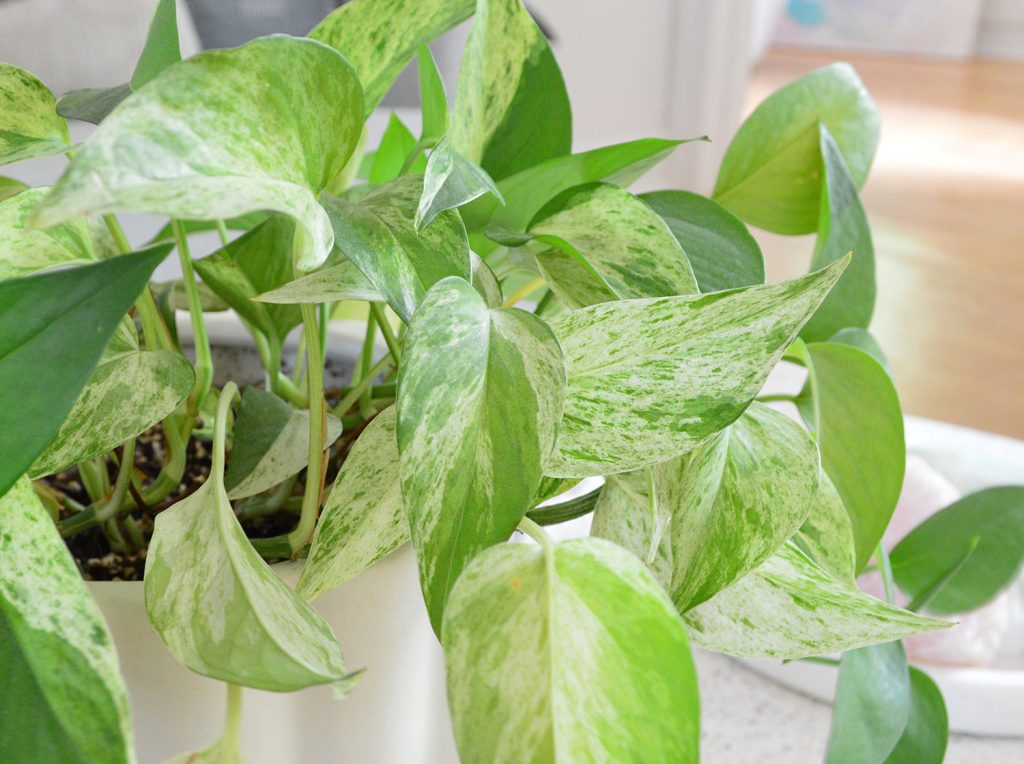
Like most pothos varieties, Marble Queens are easy to care for and can grow long dramatic vines that make them great houseplants. They grow fast and are difficult to kill, which makes them perfect for beginning plant owners who need a good confidence boost. And even as people who consider themselves pretty good with house plants, they’re still some of our favorites because they truly are lush and lovely.
How To Identify A Marble Queen Pothos
Marble queen pothos are easily confused with other varieties of pothos, especially the golden pothos. These plants are all the same species (Epipremnum aureum) but have been bred to look slightly different. So while knowing which variety of pothos you have is nice information, it doesn’t drastically change how you should care for your plant.
The easiest way to identify a marble queen pothos is the heavy white or cream spots and streaks on its green leaf. Golden pothos tend to have fewer, yellower variegations. The exact patterns depend on the growing environment of your pothos, so some plants may have fewer variegations than others. You can learn more about them in our golden pothos care guide.
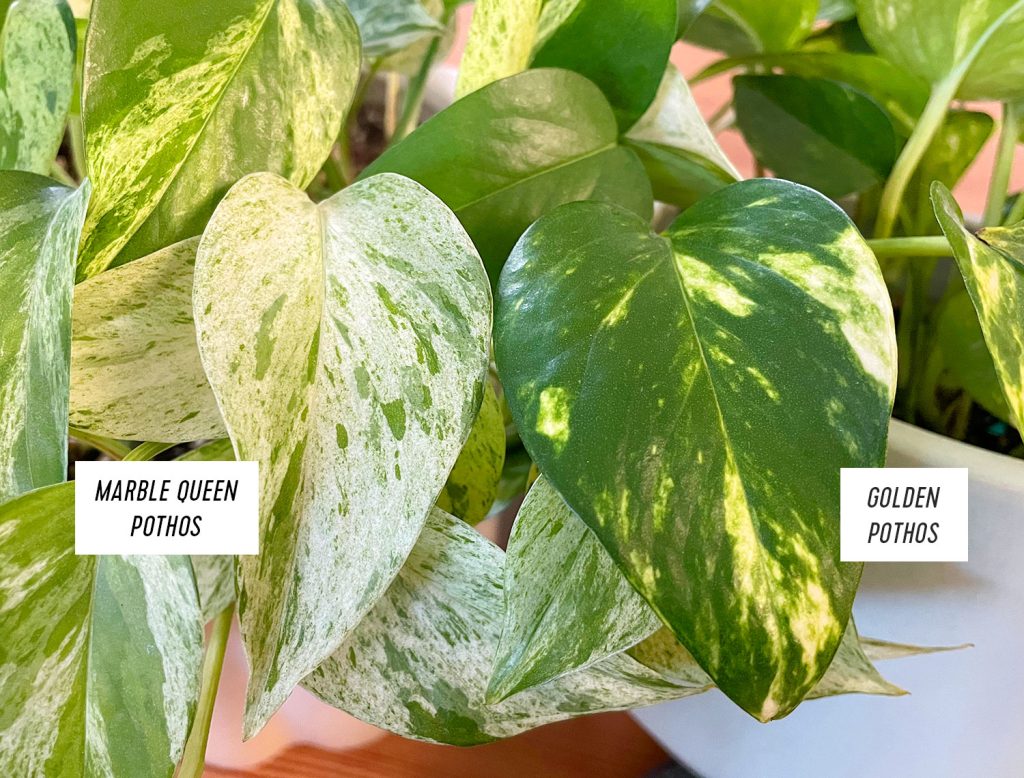
Marble queen pothos also look similar to snow queen pothos. These plants are effectively the same, but a snow queen appears to have white leaves with green variegations versus the marble queen, which has green leaves with white variegations.
How To Care For A Marble Queen Pothos
Marble queen pothos do well under a range of conditions, so they’re not a plant that requires a lot of planning or stress. We’ve got them everywhere from low-light rooms to bright porches. But here are a few basic care tips you should keep in mind.
Light
Like most pothos plants, marble queens can survive in many light conditions. They prefer medium to bright indirect light but are also one of the best low-light houseplants. The more sunlight they receive, the more white variegations the leaves will have. Brighter locations will also encourage faster, fuller growth. However, too much direct sunlight can burn the leaves.
Watering
Marble queens prefer consistent watering, but can tolerate periods of drought. So don’t worry if you miss a watering. We try to saturate the top 2 inches of soil every 7-10 during the spring & summer, and less often in the fall or winter. Pothos leaves tend to droop when they’re getting thirsty, so you can also water as needed if that’s easier for you to remember. As with most plants, underwatering is preferable to overwatering.
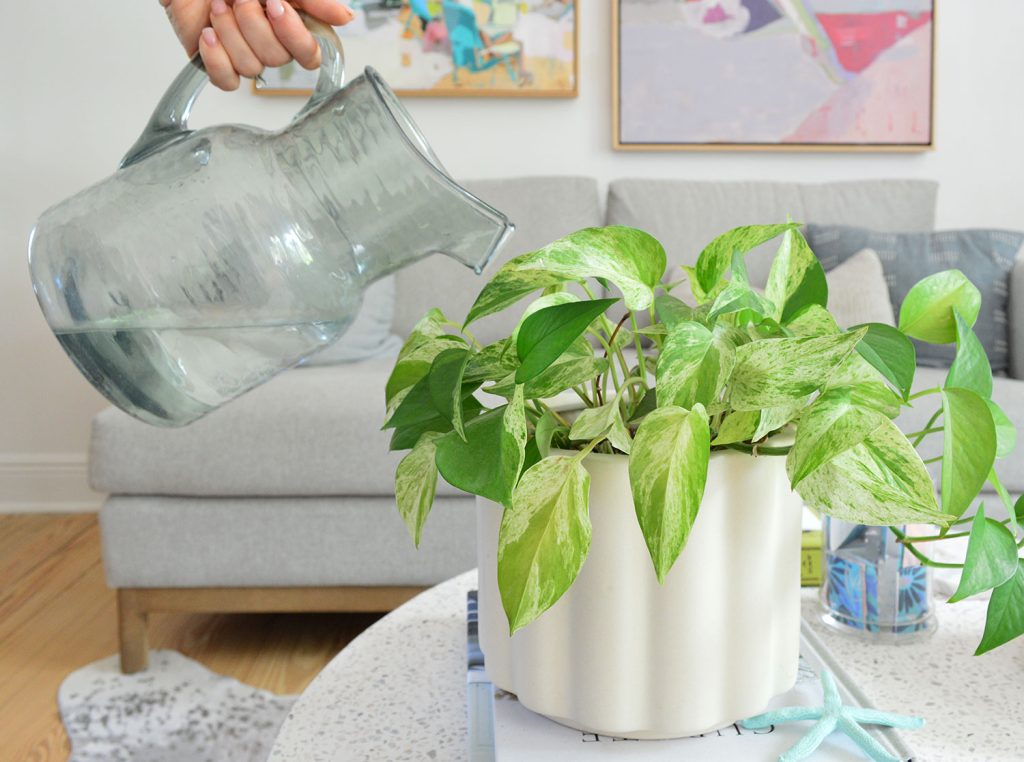
Soil & Potting
Marble queen pothos don’t require special potting mixes, as long as the soil drains well. Once it begins to outgrow its pot or the roots become compacted, repot your marble queen into a slightly larger pot with a drainage hole. You can use a standard soil mix or add perlite, lava rock, or orchid bark to keep it well-draining. They typically need repotting every 1-2 years, depending on their size and growth rate.
Temperature & Humidity
Pothos plants need temperatures between 60ºF to 85ºF and thrive best in humidity levels around 50-70%. Typical household conditions are typically great, but consider adding a humidifier or pebble tray to increase humidity in dry spaces. They tend to dislike swings in temperature, so try not to put them near heating vents, fans, or other drafts.
Pruning
You can prune your pothos to control its size and shape, or to encourage new growth. Cut off as much of each vine as you’d like, leaving at least 2-3″ inches above the soil line. Use clean, sharp scissors or shears to cut about an inch below a node (where a leaf meets the vine). Pruning is best done in the springtime during its growing season. You will also need to remove dead leaves on occasion. When they’re ready, they can be plucked off by hand.
Fertilizing
Pothos should be fine without regular fertilization. However, you can give yours a boost of nutrients by applying a balanced fertilizer monthly during its spring & summer growing season. These houseplant tablets are easy to drop into your watering can. Just be careful not to overfertilize.
How To Propagate A Marble Queen Pothos
Propagation is a technique for growing new plants from clippings and pothos are the perfect plant to learn how. If you’ve got a glass vase or vessel, there’s no reason not to try it the next time you prune your marble queen.
Step 1: Take a stem cutting
Using clean, sharp shears, cut your vine above a leaf node (where the leaf connects to the vine). We try to leave 3-4 leaves on the mother plant. You can propagate a cut vine as a whole, or cut above and below the individual leaf nodes to propagate multiple leaves separately.
Step 2: Place the cut end in water
Put the cut end of your pothos vines inside a clear glass jar filled with at least 2″ of water, making sure no leaves are submerged. Remove lower leaves if needed. Find a partially sunny spot where you can place your vessel for several weeks.
Step 3: Wait for roots, then transfer to soil
After a week or two, you should see roots begin to appear. Once they have grown a least an inch or two, plant them into a pot with soil like you would any plant. Find a spot for your new marble queen and care for it as normal.
Common Pothos Issues
Marble queen pothos are susceptible to common problems, just like any houseplant. We haven’t had any issues with ours, but here are some things to look out for.
- Yellowing leaves: Don’t be alarmed by the occasional yellow leaf, since those are a natural part of the plant’s life cycle. Widespread yellowing, however, may indicate overwatering and the onset of root rot. Space out your regular waterings or use less water. If that doesn’t work, consider moving to new, better-draining soil.
- Brown or crispy leaves: These could be due to underwatering, low humidity, or too much direct sunlight. Try watering or misting your pothos, or move it to a lower-light location.
- Drooping leaves: Your pothos is underwatered and needs a drink! Water it like normal and it should perk up within the day.
- Pests: Pothos don’t tend to have many pest issues, but can see infestations of fungus gnats, mealybugs, spider mites, and more. If you see any insects or webs present they can typically be removed with water and the plant can be treated with a natural neem oil application.
Other Marble Queen FAQ
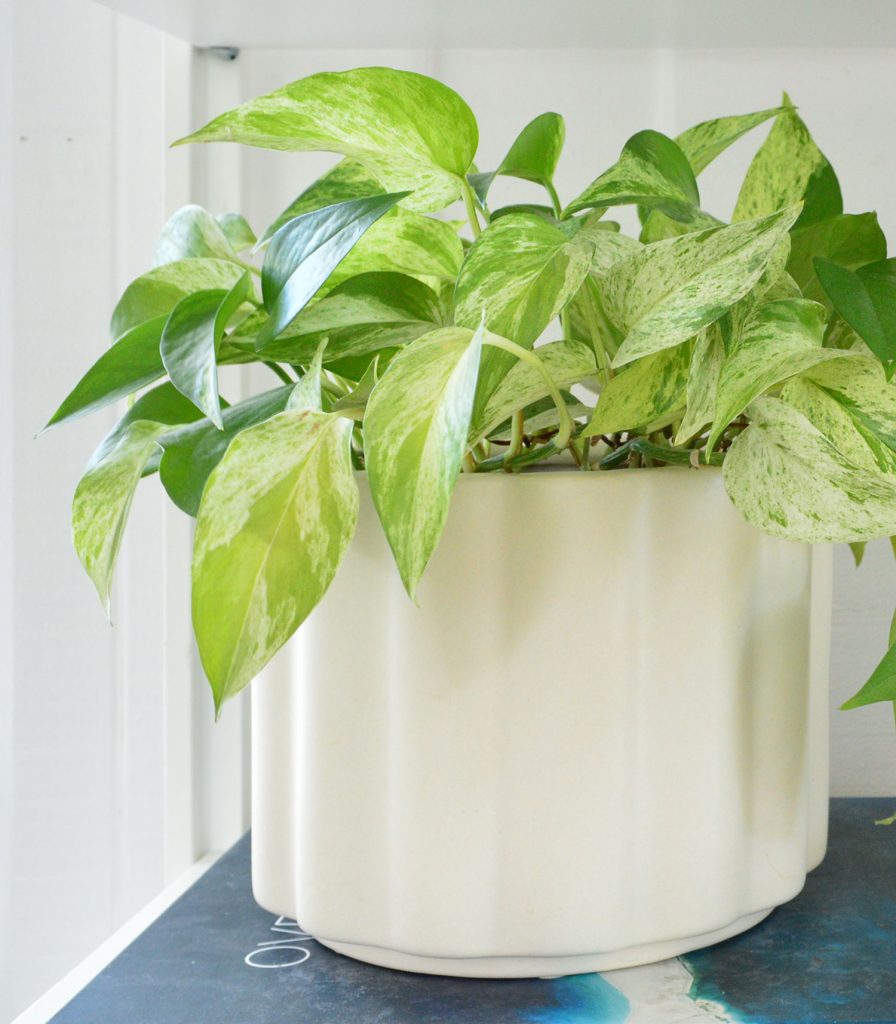
Are marble pothos toxic to cats?
Pothos are toxic to cats, dogs, and humans if ingested. It contains an undigestible mineral called calcium oxalate that causes irritation when swallowed. Effects are typically mild, but it’s safest to keep marble queen pothos are away from any pets or children that you worry might take a nibble.
Can marble pothos be grown in water?
Yes! If you enjoy watching the roots grow on your marble queen pothos, the plant can survive if kept in water. It is recommended that this is done with a new vine clipping, not a full plant already accustomed to soil. Just be sure to change the water frequently to keep the plant healthy. You may also need to occasionally clean algae or other growth from the sides of the vessel.
Can marble pothos be outdoors?
Yes! Marble queen pothos can live outdoors in USDA Plant Hardiness Zones 10-12. Alternatively, you can also place them outdoors in containers that can be moved in when temperatures drop below 50. Just choose a location where it doesn’t get too much direct sunlight. We currently have a happy marble queen pothos on our outdoor plant shelf.
What other types of pothos are there?
Marble queen pothos are a popular type of pothos, but there are more than a dozen other varieties. Golden pothos is the most common, but others include the neon pothos, Manjula Pothos, Cebu Blue Pothos, Snow Queen Pothos, Jade Pothos, and Baltic Blue Pothos. Each has a slightly different color, leaf shape, or variegation pattern.
More Plant Guides

If you’re looking for more information on some of our favorite plants, check out some of these posts below:
- Best Low-Light Houseplants
- Best Air Purifying Indoor Plants
- Golden Pothos Care Guide
- Neon Pothos Care Guide
- Monstera Deliciosa Care Guide
- Snake Plant Care Guide
- Aglaonema Plant Care Guide
- Corn Plant Care Guide
- Fiddle Leaf Fig Care Guide
- Tree Philodendron Care Guide
- How to Build An Easy Plant Shelf
- Make A DIY Wire Trellis
- Protecting Outdoor Plants In A Deep Freeze
*This post contains affiliate links, so we may earn a small commission when you make a purchase through links on our site at no additional cost to you.
